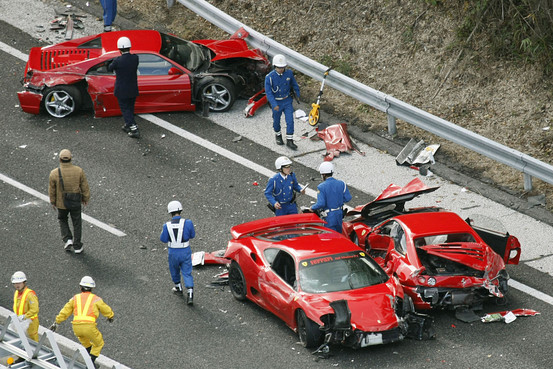 An accident on a highway in Japan on Sunday involving a bunch of supercars has been dubbed ‘the world’s most expensive car crash ever.’
An accident on a highway in Japan on Sunday involving a bunch of supercars has been dubbed ‘the world’s most expensive car crash ever.’
Eight Ferraris, one Lamborghini Diablo, a Nissan GT-R Skyline and three Mercedes Benz were involved in the smash. The Wall Street Journal reported that the total value of the cars involved could be as much as $4 million.
Oh, and there was a Toyota Prius caught in the 14-car pile-up too.
According to reports, the crash happened on a rain-soaked road during a day out for the luxury-car drivers, an event the executive officer of the region’s Traffic Police Unit Mitsuyoshi Isejima called “a gathering of narcissists.”
Isejima said the incident, which happened on a curve on a major highway in the western part of the country, was caused by a 60-year-old male driver of one of the Ferraris losing control and swerving into the central barrier before spinning across the road into the path of the other sports cars. It’s been suggested the cars were traveling at speeds of around 150 km/h (about 90 mph). Debris was spread across a distance of some 400 meters.
Apparently the drivers of two Mercedez Benz were heading in the opposite direction on the highway but were hit by flying debris.
Despite the carnage, no one was seriously injured in the accident though about 10 people suffered minor injuries.
The crash involved a whole heap of pricey cars, including a Ferrari F-360 worth more than 18 million yen ($230,000).
The driver who is thought to have caused the accident could receive a three month jail sentence or a fine of 100,000 yen ($1,285). If he can afford a Ferrari F-360, you can bet the $1,285 fine is looking like the more attractive of the two punishments.
[Source: Bloomberg, WSJ] [Image: Kyodo News/AP]


